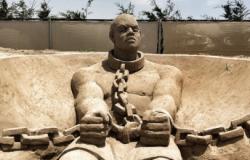40.3 Million Slaves: Challenging the Hypocrisy of Modern Slavery Statistics

The new estimates on modern slavery hide incontrovertible biases within them, but their weight will be used to justify the actions of ‘white saviours’ for years to come.
The emotive power of ‘slavery statistics’ is reflected in how unquestioned they are within the mainstream press. There are over 40 million slaves in the world today, a new report from the International Labour Organisation and the Walk Free Foundation said in September, and around the world the number went: 40 million slaves on Facebook, 40 million slaves on Twitter, 40 million slaves in the The Washington Post, the Guardian, the Independent, Spiegel Online, Al Jazeera, the Hindu. Apart from Daniel Mügge’s analysis for this site, can you think of anywhere that has responded critically to the release of the Global Estimates of Modern Slavery, or acknowledged in their reporting the substantial criticism levelled against Walk Free’s methodology in the past?
The UN enshrined the eradication of modern slavery by 2030 into sustainable development goal 8.7. But, “the world won’t be in a position to achieve the sustainable development goals unless we dramatically increase our efforts to end these scourges”, warned Guy Ryder, the director-general of the ILO. “These new global estimates can help shape and develop interventions to prevent both forced labour and child labour”.
There are a number of problems with all this. Neither the producers of the new estimates nor the reporting around them acknowledge the imperialistic nature of the statistics themselves, or the influence of exclusively western thinking upon them. The individuals and institutions involved are furthermore reticent to see the racist echoes of Kipling’s ‘white man’s burden’ underlying their creation and within the policy-making surrounding them. These variations on a theme are not entirely distinct from one another, nor are they the same. The challenge here is to break down the narrative of the contemporary abolitionist movement, and highlight the racial undertones of the discourse; the abolitionist cultural imperialism.
Abolitionist cultural imperialism
The key players in what is most effectively described as the ‘contemporary abolitionist movement’ are easily identifiable, with the Walk Free Foundation positioning itself as its champion. Founded in 2013 by the family of mining magnate, Andrew Forrest, Walk Free orchestrated the first Global Slavery Index (GSI) and supported this latest, UN-backed edition. Both deploy the moral power of the term ‘slavery’ to generate outrage against what their authors class as ‘modern slavery’, and use statistics to bolster the legitimacy of their claims.
The numbers, however, hide an implicitly racist bias. For example, previous editions of the Global Slavery Index, the flagship product of the Walk Free Foundation, identified the ‘best’ and ‘worst’ states fighting contemporary slavery, praising the former and shaming the latter. Unsurprisingly, the best were all Euro-American and the worst African and Asian – a setup which positions the predominately white West as morally superior to and leader of the non-West.
This is an incomplete view to say the least, one which is only made possible by selectively cherry-picking developments that confirm the overall view. For example, the GSI lauds legislation like the UK’s Modern Slavery Act while overlooking the lethal consequences of UK immigration policies or the effects of Western neoliberalism on the non-West. Is this not a classic form of whitewashing and cultural imperialism?
Similar things can be said about the inclusion of ‘forced and child marriage’ in this new round of estimates. For instance, if forced marriage is a form of slavery, why isn’t forced motherhood? British Prime Minister Theresa May styles herself as leading the fight against ‘modern slavery’ and has gone on record in support of these estimates – thereby agreeing that forced marriage is a form of contemporary slavery – yet she remains virtually silent over the issue of abortion access in Northern Ireland. What is the difference?
Likewise with child marriage. Plenty of children from predominantly non-White countries are said to have been forced into marriage, implying that the cultural backwardness of their societies leaves the Western world little choice but to lift them up and rescue them. For if the West won’t intervene, who will? But in the UK, ‘children’ aged over 16 can get married so long as their parents consent. How, then, are they not also victims of modern slavery, victims of ‘cultural backwardness’?
The point here is that the elasticity of the term ‘slavery’ and its very selective application obscures the power relations behind any determination of what counts as a problem. In this case, the racialised and culturally imperialist biases of those doing the determining are clear to see. The British government makes its positions clear through its policies on abortion, marriage, migration, and the right to work. The Walk Free Foundation on how it chooses to collect, compare, and display data. The message these positions promote is that the Western saviours of the world can do no wrong, especially in interaction with corrupt, culturally inferior ‘others’.
A new ‘civilising mission’?
At their core, then, these latest modern slavery statistics appear to implicitly charge those from ‘superior’ cultures with the same ‘civilising mission’ that Kipling mandated to his fellow colonists in the early twentieth century. The use of the term ‘slavery’ is designed to shock and provoke moral panic in response to apparent injustice. Yet those injustices and the anti-slavery response to them are racially coded, with white superiority and non-white inferiority written into their DNA. Indeed, it is no coincidence that the imagery deployed by the abolitionist movement often echoes colonial imagery, with individuals framed as victims of their own society, from which they require liberation by the morally guided white rescuer.
Overly simplistic calls to ‘free the slaves’ in response to the release of these latest statistics fail to recognise how the contemporary abolitionist movement is being wielded as a hypocritical weapon of morality. It seeks to ‘civilise’ cultures which fail to adhere to the moral standards and expectations of the certain quarters of the West, without acknowledging either the West’s role in perpetuating inequality, injustice and exploitation overseas, or the West’s frequent failure to live up to its own ideals at home. Until these factors and structural relationships are acknowledged, and a whole new map of where (and at whose behest) exploitation occurs, the fight against ‘modern slavery’ remains a hollow call.
Elizabeth A. Faulkner is a lecturer in law at Staffordshire University. She recently completed her doctoral thesis ‘The Trafficking of Children; International Law, Modern Slavery and the New Abolitionists’ at De Montfort University. Her interests, broadly conceived, are in international child law, human rights, and gender and the law, and she specialises in human trafficking, migration, slavery, exploitation and sexual violence.
This post first appeared on:
Credit Image: muammerokumus Via Flickr (CC BY-SA 2.0)


